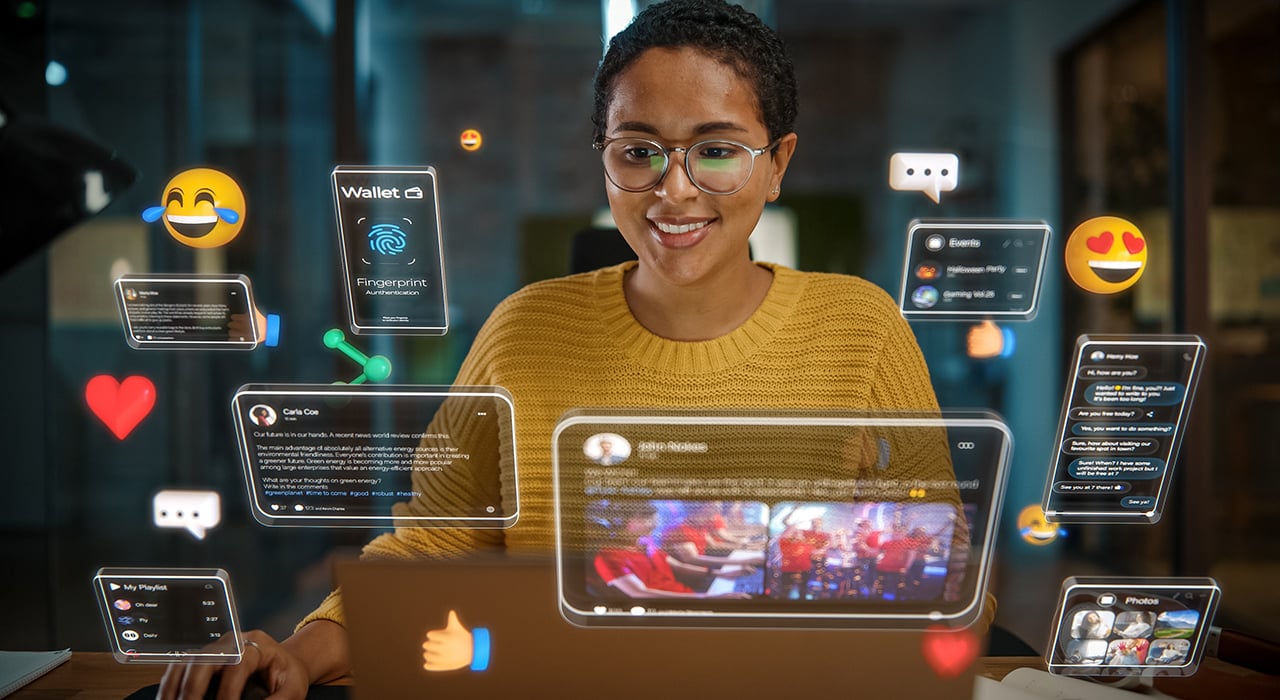
Dan Tull
Copywriter

Last week we talked about how technology in TV and Film has had a profound and often predictive impact on the real world. I opened up the floor to my wonderful colleagues at Crowd to see whether they’d seen examples of media predicting the future and whether they could see any potential examples today.
Wall-E, the Nostradamus of technology: Xena Watts, Marketing Executive
Our first submission came from Xena, who suggests that Wall-E held some predictive abilities. Wall-E is a beloved Pixar film that portrays a dystopian future in which humanity has abandoned the Earth due to environmental degradation. As it turns out, Wall-E was extremely good at predicting the future of technology, which for a film that came out in 2008 is quite impressive. The film features several advanced technologies that seem far-fetched but have now become a reality. Let’s just hope that its predictions end with technological advancements and not environmental degradation.
In Wall-E, advertising is personalised and targeted to the individual. This technology has become a reality through the use of big data and machine learning algorithms, which enable companies to collect and analyse vast amounts of data on individuals and their preferences to deliver targeted advertisements. Companies such as Facebook, Google, and Amazon use this technology to offer personalised advertising to their users.
In the film, the humans travel around the spaceship in autonomous chairs, which transport them to their desired location. Autonomous vehicles have become increasingly prevalent in recent years, with companies such as Tesla and Waymo investing heavily in self-driving technology. Self-driving cars are already being tested on roads and highways, and some cities are experimenting with autonomous buses and taxis.
Wall-E is able to interact with the humans using voice commands. Voice-activated technology has become ubiquitous, with devices such as Amazon's Alexa and Apple's Siri enabling users to control their homes, play music, and perform other tasks using voice commands. This technology has become an integral part of the smart home ecosystem and has opened up new possibilities for hands-free interaction with technology.
The humans on the spaceship spend much of their time in virtual reality, experiencing simulated environments and activities. Virtual reality technology has advanced significantly in recent years and is now used for a range of applications, from gaming and entertainment to education and training. Companies such as Oculus and HTC offer high-end virtual reality headsets, and mobile devices such as smartphones can be used with inexpensive VR viewers. This brings us nicely into our next submission…
Johnny Quest and the new frontier of virtual reality: Brett Magill, Digital Performance Manager
“Although I love the idea of Johnny Quest, I doubt that VR will be what we want it to be for quite a while. I believe that when we can make VR cheap and accessible to countries with large populations like India or China and then the US, we may see it grow into an online space - an escape. This won't be "the next internet" but rather running alongside it. It will be something simpler and more intuitive, a mixture of AR and VR technology combined with work-from-home culture. The costs of living, prevalence of internet access throughout the world, and a more integrated global society mean that we can look forward to the development of better, more user-centric VR technology one day.”
Virtual reality is a fascinating frontier, and probably one of the most explored science fiction tropes that has made its way into the real world. The spectrum of functionality demonstrated by VR can be quite large depending on the media, Star Trek has a holodeck that can essentially recreate anywhere whilst something like Ready Player One features slightly more grounded hardware although the world they end up in is wildly fantastical.
In reality, VR is being hamstrung by cost and a sluggish response by consumers to adopt the technology. Most of the functionality is there, and it’s quite breathtaking to try out. The big push, like Brett points out, is how this merges with working culture. We’ve seen what the Metaverse is trying to do, but how many people will realistically buy into the culture of putting a headset over their eyes for a full working day? I think there is still a few more years before it becomes commonplace, as the hardware costs are still prohibitive to most people and the concept has not been normalised enough for non-tech heads.
The utopian ideal of being able to work from home whilst still maintaining a semblance of human interaction is certainly appealing, but the darker side of this reality is that we lose our balance. It is definitely advantageous to be able to be in the room with people physically for certain moments.
From a client services perspective, I can see the value of operating within a 3D space when conducting online meetings, but we should also keep in mind that many people are still encountering frustrations with digital conferencing as it stands now. If webcams and microphones are still causing issues, the idea of VR is certainly a way off becoming standard practice.
The notion of using technology to enhance building empathetic relationships is one that we will explore more with the next film…
M3gan, from functional to emotional: Kyle Anderson, Social Media Manager
Part of what separates machines from humans is the lack of emotional capabilities. A machine cannot rationalise the emotional weight of a decision, often instead opting for efficiency over empathy. This brings us nicely to M3gan, a horror film about AI gone awry. The basic premise is that a workaholic inventor creates an AI automaton that can independently learn. She then allows her recently orphaned niece to act as the guide for this AI, named Meghan, and instals parameters to ensure that she maintains control over her niece's robotic companion. Naturally, being a horror film things don’t go according to plan but let’s look at what the real world could offer in this area.
2023 seems to be shaping up to be the year for AI, and what we are currently seeing is the exponential growth and improvement of the underlying technology. The application of AI is still very much practical and functional. M3ghan introduces the idea that a human could develop a genuine emotional connection with a machine that has been programmed to understand empathy and sympathy. This is an interesting concept that will almost certainly be something we see expanded on in the next decade. Whilst there have been huge strides forward in opening up discussions about mental health, there is still a lot of stigma surrounding the subject, especially within the workplace. A truly confident environment to offload stresses and thoughts would be with an artificial intelligence that is programmed to listen and help.
From a business perspective, building in empathetic capabilities within an AI would serve a purpose when it comes to chatbots. Instead of generic “one-size fits all” responses that are commonly seen, chatbots instead could understand user issues on a case-by-case basis and therefore provide valuable and tailored solutions.
The Hitchhiker’s Guide to the Future: Steve Howling, Creative Director
“The Hitchhiker's Guide to the Galaxy isn’t just full of great characters and jokes, it’s also full of ideas. Ideas that like the writing, were ahead of their time. When I first read the books at around 12 years old I felt that the inventions created by Douglas Adams seemed to make sense. And over the years, many of these great leaps of imagination have turned into reality. The Hitchhiker's Guide itself was an electronic book, 29 years before the release of Kindle, or the ipad. Being able to search through an endless number of electronic pages seemed a lot more logical than buying a huge and cumbersome set of encyclopaedias (Yes.I was born in the 70s). The guide was a source created by many different writers supplying copy, and doing their best to offer useful advice - a very accurate description of Wikipedia which was to follow.“
Douglas also touched on touch screens, voice control and even gesture control. The idea of ‘waving in the general direction’ to control a device is still in its infancy today, while touching a screen and talking to a computer is now taken for granted. The characters in the Hitchhiker's Guide would just mention Eddie the computer's name, and its circuits would spring to life and answer in a cheerful and helpful way. Siri and Alexa described perfectly.
Although the book didn’t exactly describe the internet, the ‘Sub Etha’ that Douglas created spoke to the idea of connecting people and sharing ideas. The obvious benefits of being able to video call people anywhere at any time seemed exciting at the time - and still is unless it’s at 6.30 in the morning!
Another idea that has now become reality is giving machines human personalities. From Marvin the paranoid android to doors that love to open up for you - we’re beginning to put human personalities into more and more devices to enable us to connect with them.
Since Hitchhiker's Guide to the Galaxy there have been countless science fiction movies and books portraying different visions and technologies of the future, but Douglas Adams made them feel like everyday objects with their own cheesy marketing slogans. And maybe it's that down-to-earth perspective that made his inventions seem so inevitable.
Bonus Round: Inspector Morse wanted smartphones: Steve Howling, Creative Director
“For me, I always get a chill thinking back to an episode of Inspector Morse. I forget the exact episode, but it had something to do with a church tower. Regardless of the plot, the curmudgeonly detective was finding it difficult to text with an old Nokia mobile telephone. I remember him being quite irate about it. A little under 7-8 years later, we have smartphones with very easy-to-use keypads that are forgiving even to big-thumbed people such as my ex-wife. It's scary how insightful Inspector Morse was. Perhaps Steve Jobs was watching, and it sparked an idea. Who's to know?”
It took me some time to find the specific episode that Steve is referring to here (thanks…) but I eventually managed to track it down. The episode, titled “The Wench is Dead” came out in 1998, well before the idea of smartphones. It’s an interesting take from Steve, as the episode doesn’t necessarily predict the future, but instead raises questions that will later be answered. Morse’s frustration with sending a text message was shared by nearly everyone who owned a mobile phone pre-smartphone, and one of the major selling points of the original iPhone was the full qwerty keyboard which in turn has influenced every smartphone since.
It seems crazy to look back from 2023 and see not that long ago we were using numerical keypads to approximate texts. I think this is a great example of how tech companies can look at current media and use it as a form of market research. Remember, all these shows or films are written by humans who are likely representing their own struggles or issues through the scripts.
The progression of mobile phones in the early stages is an example of the notion that sometimes great ideas can find themselves on the wrong developmental path, and it takes something quite drastic to shift the public view. If mobile phones had continued on the trajectory of their early years, what would they look like? It is in the innovation of looking at an existing product and seeing ways to improve upon it that led us to a world where smartphones are so ubiquitous with modern life. I wonder what other technological creations would benefit from the same approach.
It was always in front of us
The real-world technologies that have emerged since all of these projects were released highlights the rapid pace of technological change. The technologies that were once the stuff of science fiction are now part of our everyday lives, and new innovations are emerging all the time. As we look to the future, it's essential to consider the potential impacts of these technologies on our lives and on the environment.
What are your thoughts? We’d love to hear about anything we’ve missed. If you want to read our previous article on the subject, follow the link here.



